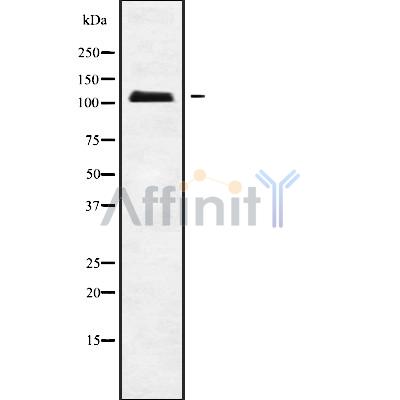APOB48R Antibody - #DF10147
| Product: | APOB48R Antibody |
| Catalog: | DF10147 |
| Description: | Rabbit polyclonal antibody to APOB48R |
| Application: | WB |
| Reactivity: | Human |
| Prediction: | Pig, Horse, Rabbit, Dog |
| Mol.Wt.: | 115 kDa; 116kD(Calculated). |
| Uniprot: | Q0VD83 |
| RRID: | AB_2840727 |
Product Info
*The optimal dilutions should be determined by the end user.
*Tips:
WB: For western blot detection of denatured protein samples. IHC: For immunohistochemical detection of paraffin sections (IHC-p) or frozen sections (IHC-f) of tissue samples. IF/ICC: For immunofluorescence detection of cell samples. ELISA(peptide): For ELISA detection of antigenic peptide.
Cite Format: Affinity Biosciences Cat# DF10147, RRID:AB_2840727.
Fold/Unfold
apo b-100; APOB; apoB-48R; APOBR; APOBR_HUMAN; Apolipoprotein B receptor; Apolipoprotein B-100 receptor; Apolipoprotein B-48 receptor; Apolipoprotein B48 receptor;
Immunogens
A synthesized peptide derived from human APOB48R, corresponding to a region within C-terminal amino acids.
Expressed in peripheral blood leukocytes > bone marrow = spleen > lymph node, and only faintly visible in appendix and thymus. Expressed in the brain, heart, kidney, liver, lung, pancreas, and placenta. Expressed primarily by reticuloendothelial cells: monocytes, macrophages, and endothelial cells. Expressed in atherosclerotic lesion foam cells.
- Q0VD83 APOBR_HUMAN:
- Protein BLAST With
- NCBI/
- ExPASy/
- Uniprot
MDFLRLYLPGLHQALRGALDSLGTFVSYLLGDAVPTVEREAQAAEELGVVAVGKTGKIVEEEAQEDLEGLRGSQNEGAGRLRGPGDDRRHEVGSSAVEQTWGWGDGSSHGSQAERQDSGAGETAKAARCQEPSAHLEARKKSKAGSGACQDRSGQAQERQESHEQEVNREERLRSWEQEEEEEEVRAREPGMARGAESEWTWHGETEGKAGAVGPKAAGDNREMEQGVREADAGETEEPGAEGAGKGEEVVVVEKACESTRAWGTWGPGAEPEDWGILGREEARTTPGREEARAILDGEEARTISGGEEAETASGGEEAETASGGEEAGTASGGEEAGIASGGEAGTASGGEEAGTASGGEEAGTASGGDEAWTTSGKEEADLLGVRQTEYGAVPGERLLEATGKVWVLEEEGDEEREAEVSPFPKQPQVLGTERTEEAAESQTAGREAVGGQEAGESFEGQVDLRGKEAEMRQDLGIRADRARMEELVQAEEAQEERGSSRDPVAELPSDGEAEGTADLEATPEARPEEELTGEESEAAQTSCGLLGVEWGGLTHSVTKGQGPELMGGAQTPTKQPEEREAGEVELMGVLALSKEEQERSLEAGPRHAGSVKPEASEAFPGAWENRTRKDMERGNTQEDAADGEQREEEETAGGQTLAAEAEGDRESELSEVPEAGGEGLTTQDAGCGTEEGEASVSENQELDGSTGADAGPCPSLGEAYARETEDEEAEADRTSRRGWRLQAVAVGLPDREDAQTGSVAAGIMGGDVVPHISAAGAGEALEGVLGQGWDSKEKEEAAAGEHAGGQEFGLEGSAEEEVTGRGSQVEAFESREGGPWGGRVEAEESAGAEDSCGLDPAGSQTARAEGMGAMVEAGGLLEKWTLLEEEAVGWQEREQREDSEGRCGDYHPEGEAPRLLDAEGLMVTGGRRAEAKETEPESLEHVRGQEEQPTHQAPAEAAPESVGEAETAEAMGSARGGAANSWSEAPLPGSLLDVSVPRSRVHLSRSSSQRRSRPSFRRTPAWEQQEEPPAPNPPEEELSAPEQRPLQLEEPLEPSPLRHDGTPVPARRRPLGHGFGLAHPGMMQELQARLGRPKPQ
Predictions
Score>80(red) has high confidence and is suggested to be used for WB detection. *The prediction model is mainly based on the alignment of immunogen sequences, the results are for reference only, not as the basis of quality assurance.
High(score>80) Medium(80>score>50) Low(score<50) No confidence
Research Backgrounds
Macrophage receptor that binds to the apolipoprotein B48 (APOB) of dietary triglyceride (TG)-rich lipoproteins (TRL) or to a like domain of APOB in hypertriglyceridemic very low density lipoprotein (HTG-VLDL). Binds and internalizes TRL when out of the context of the macrophage. May provide essential lipids to reticuloendothelial cells. Could also be involved in foam cell formation with elevated TRL and remnant lipoprotein (RLP). Mediates the rapid high-affinity uptake of chylomicrons (CM), HTG-VLDL, and trypsinized (tryp) VLDL devoid of APOE in vitro in macrophages.
There are 2 forms in macrophages, the membrane-binding proteins 200 kDa (MBP 200) and 235 kDa (MBP 235), that can be reduced into a single active ligand-binding species with intermediate mobility (MBP 200R).
Cell membrane>Peripheral membrane protein.
Note: Binds monocyte-macrophage membrane. Thought to be anchored in the membrane through an interaction with an integral membrane protein.
Expressed in peripheral blood leukocytes > bone marrow = spleen > lymph node, and only faintly visible in appendix and thymus. Expressed in the brain, heart, kidney, liver, lung, pancreas, and placenta. Expressed primarily by reticuloendothelial cells: monocytes, macrophages, and endothelial cells. Expressed in atherosclerotic lesion foam cells.
Restrictive clause
Affinity Biosciences tests all products strictly. Citations are provided as a resource for additional applications that have not been validated by Affinity Biosciences. Please choose the appropriate format for each application and consult Materials and Methods sections for additional details about the use of any product in these publications.
For Research Use Only.
Not for use in diagnostic or therapeutic procedures. Not for resale. Not for distribution without written consent. Affinity Biosciences will not be held responsible for patent infringement or other violations that may occur with the use of our products. Affinity Biosciences, Affinity Biosciences Logo and all other trademarks are the property of Affinity Biosciences LTD.
